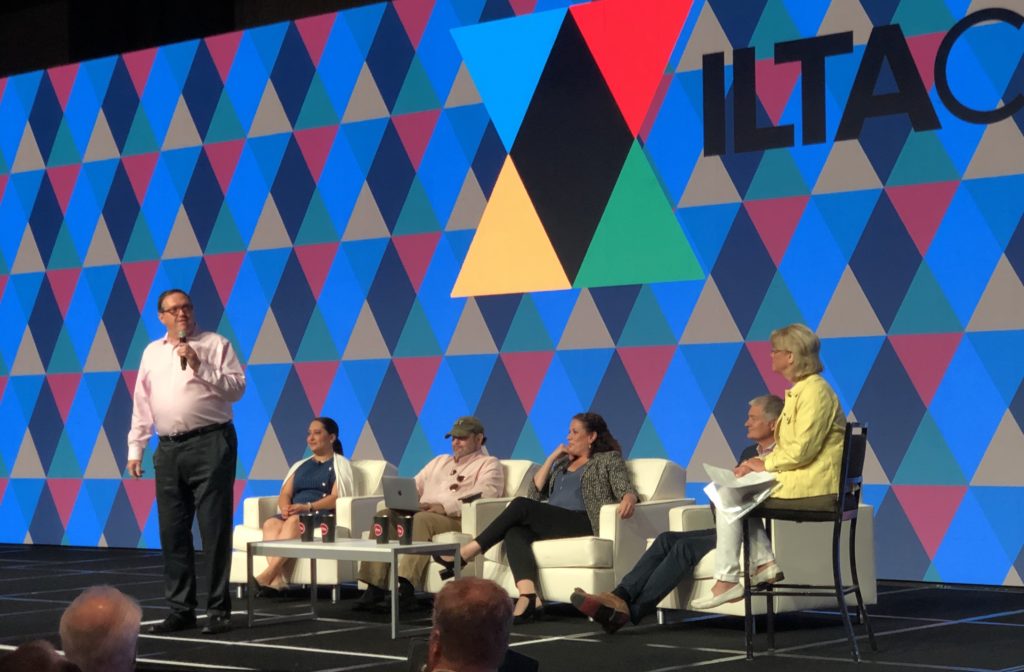This is a live post from the International Legal Technology Association (ILTA) annual conference, ILTACon 2019. This session is Is Disruption a Threat or an Opportunity?
As with all my live posts, please forgive typos and any misunderstanding of meanings. I write this in real time and post as the session ends.
The speakers for this session are:
- Janet Day, Consultant, Janet Day Limited. Moderator
- Katie DeBord, Chief Innovation Officer, Bryan Cave Leighton Paisner LLP
- Paul Domnick, President, Litera Microsystems
- Dazza Greenwood, Founder, CIVICS.com
- Farrah Pepper, Chief Legal Innovation Counsel, Marsh & McLennan Companies, Inc.

After my session report, I append the session description .
Session Report
Janet introduces the session: is the disruption that threat raises a threat or an opportunity.
Q: Do clients care how law firms do what they do?
Farrah: Yes, increasingly so: clients do care how firms get to results. She speaks for herself and her in-house peers. Frames this with her view on where in-house practice is. There has never been more of an effort to bring services in-house. Farrah started at a firm, then went to GE law department. In her current role, she sees a big focus on the value proposition: how to do things right and well, a big focus on serving internal clients. The focus is to reduce effort and focus on the highest value activities. Cites downward pressure to do more with less. As Chief Legal Innovation Counsel, biggest question I get – what is this role? Part of the answer is collecting and propagating the lessons learned across the department.
Q: What are the technologies that young lawyers want to use?
Dazza: I have worked with students over the last few years. Has seen a few basic patterns: First, this cohort was born digitally and that means mobile first. This has implications across systems. And does not reflect big firm IT architecture. Second: collaboration, within and across organizations, eg, Google Docs and Slack. Of course, these raise security questions. We need to find a way to support this style of work. In sum: mobile-first, collaboration, and web-centric. This will create expectation gap on entry to practice.
Q: Communication and messaging in law firms re technology?
Katie: All legal IT professionals have information that clients would like to have. Law firm leadership does not have the access to hear clients like Farrah asking for improving how lawyers work. But they would like to hear this. It’s easy to underestimate where people are on the spectrum of knowledge about tech. Most in law firms would struggle to understand 1 of 5 words at ILTA. Katie says she started writing down quotes from clients years ago to share with her law firm colleagues and law firm leadership. It’s really important for firms to hear the voice of the client. Katie also emphasize importance of multidisciplinary teams.
Q: How do suppliers think about these issues?
Paul: The important unifying theme so far is “listen to customers”. But listen for what clients wand but give them what they need. Supplier must be tuned-in to the market to understand the difference between want and need. With the entry of non-traditional legal providers, and they are not doing things radically different, they are catalyzing change in attitudes and client-centric focus. In the US, this is more of a theoretical consideration. But in Europe, the biggest firms say they worry most about the Big 4, not other firms.
Q: Thinking about change and new generation, how quickly and how much can they influence change:
Dazza: A lot, because new generations always do. But how quickly is a big question. We have to get back to what we mean by disruption. Cites evolutionary vs. revolutionary change. Disruption goes to a product or service that never previously existed, that does things in a completely new way. What that means to Dazza, the ones coming into law are probably not the ones who will disrupt. If there is disruption, it will likely come from young people solving legal problems inn different ways, those who are _not_ inside legal already. If guessing about time frame of big changes in large firms and law departments, I think it will take 3 to 6 years.
DIALOG
Paul: The advent of APIs allows a lot of low cost and easy experimentation. Opening up supplier capabilities needs to be encouraged to allow more experimentation.
Farrah: The nugget to take away is that there is a big conversation around change and disruption. If you are innovating in a vacuum, that’s called arrogance. You need to have context, you need to listen carefully, you need to find specific needs and problems to solve.
Katie: I see young lawyers being trained in different way. Law schools are starting to change how they train lawyers. New graduates therefore have different expectations. New lawyers will leave if it’s not the right environment for them.
Katie: We have many clients directed by CEO or Board to be more efficient and generate more value. My firm gets calls where clients ask to collaborate to develop better solutions. I see clients wanting to collaborate on new services. But we have to be clear on what’s an experiment and what’s business as usual.
Dazza: At Media lab, we don’t use the phrase cross-disciplinary. We say anti-disciplinary. We want to infuse a sense of conceiving the future in a different way . Try and fail fast. Collaboration is not just in your lane, go across functions.
Farrah: Along same lines, law departments no longer use the same old providers. We are crossing lanes. We now outsource all eDiscovery to a vendor and document review is next. Law firms have to think about what their value proposition is, and not coast on what they’ve always done.
Paul: What’s disruption and what’s regular change? Organizations that succeed the most will be best at managing change.
— Audience Q&A not captured —
Description
A panel of experts discuss disruption and provide insights on how it can be a threat or an opportunity. They will discuss disruptors in the legal industry including generational gaps, partnerships with legal vendors and clients and of course technology!
Archives
Blog Categories
- Alternative Legal Provider (44)
- Artificial Intelligence (AI) (57)
- Bar Regulation (13)
- Best Practices (39)
- Big Data and Data Science (14)
- Blockchain (10)
- Bloomberg Biz of Law Summit – Live (6)
- Business Intelligence (21)
- Contract Management (21)
- Cool Legal Conferences (13)
- COVID-19 (11)
- Design (5)
- Do Less Law (40)
- eDiscovery and Litigation Support (165)
- Experience Management (12)
- Extranets (11)
- General (194)
- Innovation and Change Management (188)
- Interesting Technology (105)
- Knowledge Management (229)
- Law Department Management (20)
- Law Departments / Client Service (120)
- Law Factory v. Bet the Farm (30)
- Law Firm Service Delivery (128)
- Law Firm Staffing (27)
- Law Libraries (6)
- Legal market survey featured (6)
- Legal Process Improvement (27)
- Legal Project Management (26)
- Legal Secretaries – Their Future (17)
- Legal Tech Start-Ups (18)
- Litigation Finance (5)
- Low Cost Law Firm Centers (22)
- Management and Technology (179)
- Notices re this Blog (10)
- Online Legal Services (64)
- Outsourcing (141)
- Personal Productivity (40)
- Roundup (58)
- Structure of Legal Business (2)
- Supplier News (13)
- Visual Intelligence (14)

